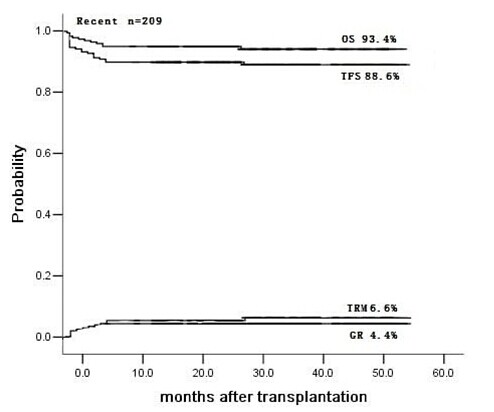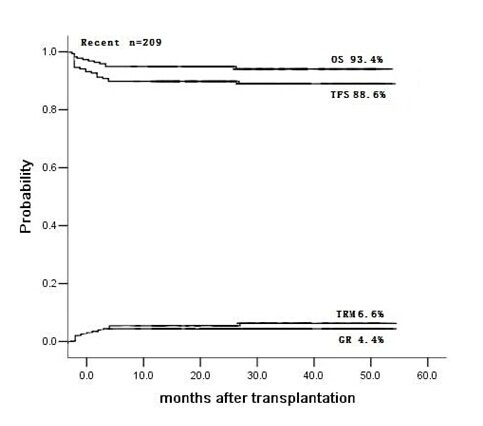Abstract
Objective
Hematopoietic cell transplantation (HSCT) is not widely used for patients with b-thalassemia major (TM) so far because of transplant toxicities. Furthermore the tangible outcomes of contemporary HSCTs in Asia are unknown.
Methods
A newly founded consortium named the Viva-Asia BMT Group collected HSCT data retrospectively and investigated whether TM-HSCT outcomes had improved in recent years in Asia and whether an upper age limit can be determined for safe transplantation.
Results
From 1991 to 2012, 422 TM-HSCTs were performed among the 8 Asian centers; half (n=209) were before January 2009 (early cohort) and the other half (n=213) were performed thereafter (recent cohort). All major outcomes including overall survival (OS), TM-free survival (TFS), incidences of graft rejection (GR) and transplant-related mortality (TRM) improved significantly in the recent cohort (OS 93.4%, TFS 88.6%, GR 4.4% and TRM 6.6%) when compared with the earlier cohort (OS 84%, TFS 68.1%, GR 17.1% and TRM 16%). In the recent cohort, favorable OS, TFS, GR and TRM were observed with unrelated donors (n=168, 92.8%, 87.8%, 4.2% and 7.2%, respectively), with one-antigen mismatched parental donors (n=26,100%, 100%, 0% and 0%, respectively), and in patients younger than 10 years (n=173, 96%, 90.8%, 4.7% and 4.0%, respectively). TFS with unrelated cord blood (35.3%) was poor.
Conclusion
The excellent outcomes of contemporary TM-HSCT in general suggest that transplantation is a viable option for many Asian patients, particularly those younger than 10 years from areas with limited resources for chronic transfusion and iron chelation.
OS, TFS, GR and TRM in (A) the total 422 patients, (B) the recent cohort, and (C) the earlier cohort. Abbreviations: GR, graft rejection; OS, overall survival; TFS, thalassemia major-free survival; TRM, transplant-related mortality.
OS, TFS, GR and TRM in (A) the total 422 patients, (B) the recent cohort, and (C) the earlier cohort. Abbreviations: GR, graft rejection; OS, overall survival; TFS, thalassemia major-free survival; TRM, transplant-related mortality.
No relevant conflicts of interest to declare.
Author notes
Asterisk with author names denotes non-ASH members.




This feature is available to Subscribers Only
Sign In or Create an Account Close Modal